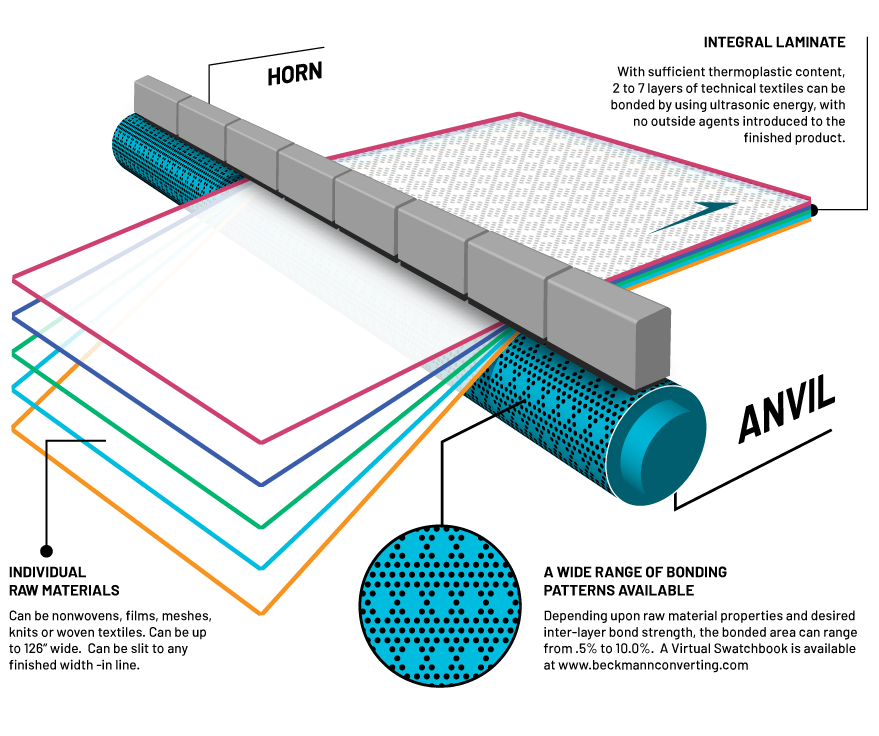Uniqueness of Ultrasonic Laminating
Beckmann Converting delivers laminates that make maximum use of the performance characteristics of each layer of the composite. Our key to success is the mastery of Ultrasonic Lamination, employing precision control to create the right amount of bonding at exact points in the textile composite.
The Uniqueness of Ultrasonic Laminating
Ultrasonic bonding technology is unique in how it accomplishes lamination of multilayer textile composites. This uniqueness offers benefits over alternative laminating approaches, including thermal bonding. Textile product design engineers can use this knowledge to their advantage when creating new media and composite materials to meet specific goals in product development.
The uniqueness of ultrasonic bonding is the fact that the vibrating sonotrodes generate energy within each of the layers of the textile composite. Melting of the thermoplastic polymers in each layer occurs only above the surface of the bonding points, the raised “pins” on the anvil roll. High quality lamination can take place without having any impact on up to 99% of the full web, leaving most of the composite component materials available to do their job!
By contrast, in thermal bonding the top layer of the textile composite needs to be in full contact with the heated roll. The heat is transferred through the top layer into the rest of the composite. Since most materials such as nonwovens, knits, and films, among others, are poor heat conductors, the high roll temperature needed to achieve bonding increases the risk of compromising the performance of the layers and the full composite. This is particularly true for the top layer.
Ultrasonic lamination is a “green” process since it does not require addition of any adhesives or other consumable materials. It is emissions-free, and it uses relatively less energy than other bonding and laminating technologies.
The uniqueness of ultrasonic bonding makes it the growing lamination strategy of choice for many different textile composite applications.
At Beckmann Converting, we have over 20 years of experience as a toll converter helping customers worldwide meet their stringent product performance requirements for multilayer textile composites through ultrasonic laminating. We have converted many millions of linear yards of materials through ongoing production programs specifically designed for each laminate. Ultrasonic laminating remains our core business as we look towards the future.
How It Works
Ultrasonic lamination uses the conversion of acoustic energy to heat to form spot welds of specific size in exact locations. This technique is an ideal method to join layers of different or similar materials (nonwovens, films, composites, or fabrics) into a single composite or laminate.

The layers of raw material are arranged and brought together as in any traditional lamination process to pass over a central rotating roll or “anvil” (see diagram above).
Instead of the uniform smooth surface roll used for pressure bonding, ultrasonic laminating uses an embossed pattern on the anvil or “pattern” roll. Each peak is the site of an individual weld through all layers of the lamination. The peaks are exactly shaped and located to yield the desired size and location of the weld. Beckmann Converting has eight different roll patterns available- see the Virtual Swatchbook to review details of each pattern and guidance on which ones may be appropriate for your application!
Acoustic energy is generated from a “horn”. Each horn is individually powered so that its output can be exactly tuned to a series of pulses. Each pulse is a pressure wave that acts as a tiny hammer. The frequency of the pulses impacts the material tens of thousands of times per second over each peak location on the anvil. While all of the material passes under the horns, welding only occurs over the peaks of the anvil.
The degree of welding at each peak is determined by the nature of the material in the layers, the amount of energy applied from the horn, the size and shape of the peak, and the “dwell” time of the material in relation to the peak. The discrete bonding at specific points is an important feature of ultrasonic lamination, as it allows the unbonded materials to function as they were designed. Our team at Beckmann Converting understands how to manage these parameters to achieve our customers' desired outcomes.
Ultrasonic lamination is a non-contact and, therefore, a non-wearing process. As the layers to be laminated move across the dwell area, the layers are not stretched or pressured onto the anvil. For effective bonding, the layers need to be flat and almost lie in a relaxed state as they dwell over the peak, so the conversion of acoustic energy to heat for bonding is not dissipated or wasted.
The Advantages of Ultrasonic Bonding Technology
Using ultrasonic bonding technology to laminate textiles offers numerous distinct advantages:
- Multiple layers of textiles, ranging from 2 layers to 7 layers or more, can be bonded in a single pass and at high speed, making ultrasonic laminating very cost effective.
- Very different materials with very different characteristics, such as physical strength, permeability of liquids or gases, and melt temperatures can be precisely bonded to form high performance composites.
- Highly uniform and consistent textile composites can be manufactured without the degradation of the individual materials due to excessive heat, pressure or chemical attack.
- The point bonding of Ultrasonic Lamination only closes permeable materials at those specific weld points. Most of the area of the material retains its original performance.
- Precision bonding can be defined to meet exact customer needs in terms of location, frequency, or pattern.
Ultrasonic Lamination is A Truly Green Process!
No adhesives or other chemicals are used in ultrasonic lamination. Only the original raw materials are present in the textile composite allowing for recycling in most cases. The process is ideal for health care, filtration and other applications where potential contamination is a concern.
The technical team at Beckmann Converting has a stellar track record of engineering solutions for implementing ultrasonic technology to laminate material combinations that have been considered "un-bondable" in the past.